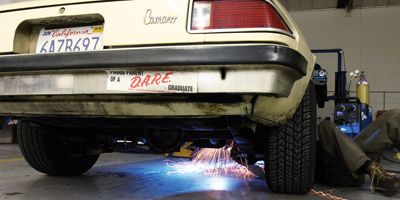
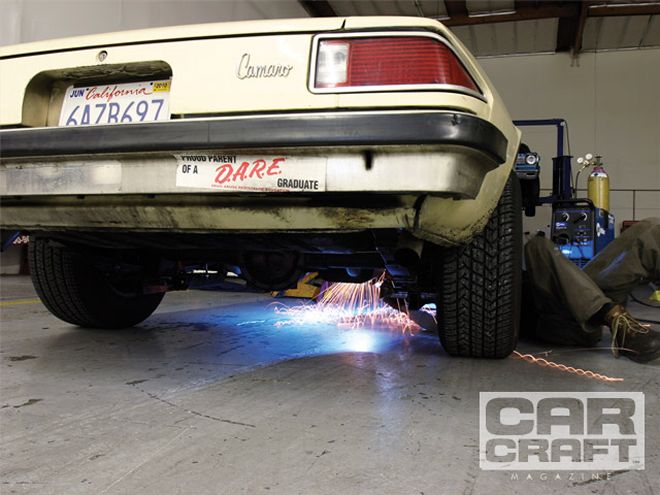
Life isn't all death and taxes, and sometimes we take ourselves a little too seriously here at CC. This is the editorial equivalent of us loosening up a bit. Normally, we wouldn't devote an entire article to exhaust cutouts or flamethrower kits, but it turns out that each of these items is a pretty strong seller in the marketplace and may represent a guilty pleasure for a guy who's otherwise all go and no show. So we decided to take a look at these fun ways to modify your exhaust.
Exhaust Cutouts
We're willing to bet that exhaust cutouts have existed almost as long as exhaust systems have. You know there was some guy who took a hacksaw to the pipes on his tiller-steered, Brass Era car and got to work annoying the neighbors.
While on the phone with DJ of Hot Rods Etc, who you'll read more about later, he told us stories of guys in the '50s cutting the filler necks off old gas tanks and splicing them into their tailpipes, gas cap, and all. Want to run loud? Unscrew the gas cap. It's so simple it's genius.
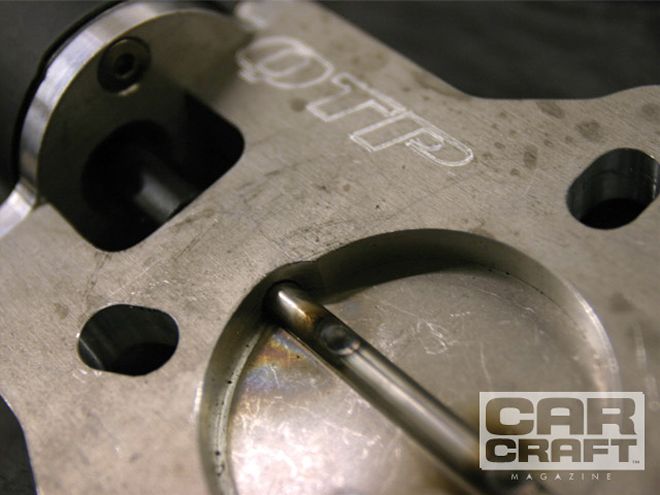 Quick Time Performance has the electric cutout market handled. Those stainless steel butterflies are actuated by permanent magnet, gear-reduction electric motors that deliver 1.5 lb-ft. Doesn't sound like much? "I wouldn't put my finger in there, let's put it that way," says Quick Time's Barry Adler.
Quick Time Performance has the electric cutout market handled. Those stainless steel butterflies are actuated by permanent magnet, gear-reduction electric motors that deliver 1.5 lb-ft. Doesn't sound like much? "I wouldn't put my finger in there, let's put it that way," says Quick Time's Barry Adler.
At some point, someone decided to package them as a kit, and soon all the performance muffler companies were offering some sort of cutout kit. Until recently, most cutouts required you to crawl under your car and unscrew the block-off plates. That takes all the spontaneity out of having cutouts, though, and these systems are better suited for the guy who wants to uncork his car at the racetrack but still wants to be able to hear himself think while driving there and back.
The high-tech kits of yesterday came with a cable-actuated flapper door that could be opened by the driver while behind the wheel. But the hot-ticket version of today is the electronic cutout with motorized flapper doors that can be opened and closed at any time from the driver seat. Based on our research, Quick Time Per-formance was the one company that jumped on this trend in a big way with several versions of electric cutouts in a variety of tube diameter shapes and sizes.
We spoke with Barry Adler, owner of Quick Time, who told us there are power gains to be had by installing his kits, depending on how restrictive your existing exhaust system is. He also said it's important to properly locate the cutouts on your pipes to get the biggest gains. We are in the process of installing a pair of Quick Time's electric cutouts on this '74 Camaro (last seen belching tire smoke on our June '09 cover). Check out the pictures to see what's involved.
If you want maximum performance from your exhaust system, build the best low-restriction system you can afford. But if you're on a tight budget or you don't want your car to be loud all the time, then these electric cutouts may be your best option. Your car can be quiet and stock-sounding most of the time-until you want the bravado and performance benefits of unrestricted exhaust.
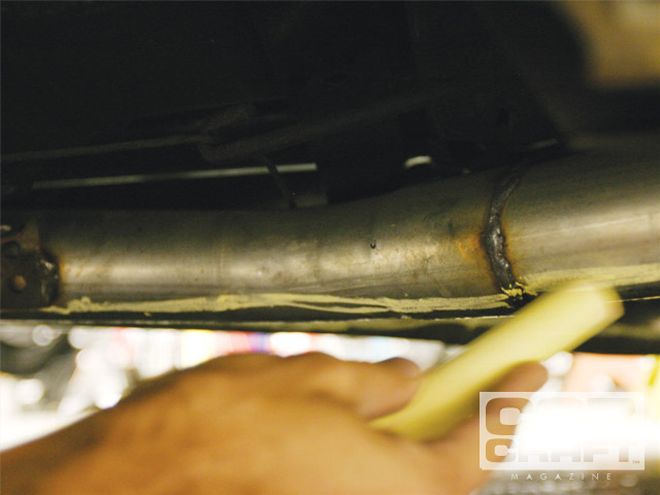
Adler tipped us off to a cool trick that allows you to determine the best placement of the cutouts on your exhaust system. Draw a line with chalk along your exhaust pipes from the header collector or catalytic converter to the muffler. Drive the car around for a while to get the exhaust system good and hot. That heat will burn off some of the chalk, leaving a faint trace of the original line. Find the spot where the chalk line remains intact. This is the optimum location for the cutouts. If space does not permit it, you can put the cutouts anywhere between this spot and the mufflers.
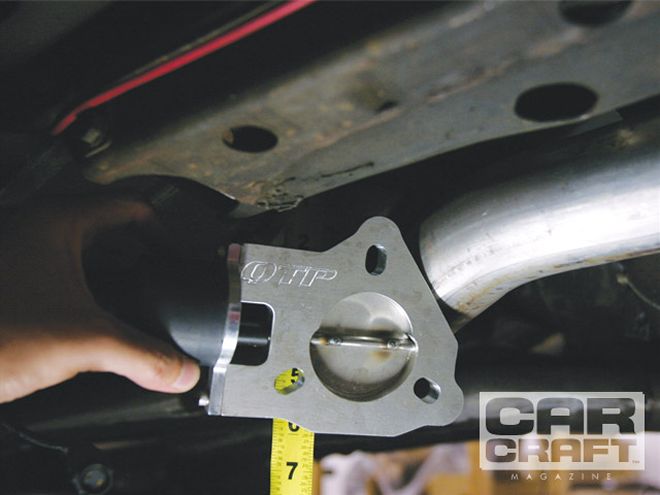
This is the spot where our Camaro would like a cutout, but you can see there's not a lot of room for the cutout housing and electric motor. We decided to install them farther downstream to where the floorpan is higher.
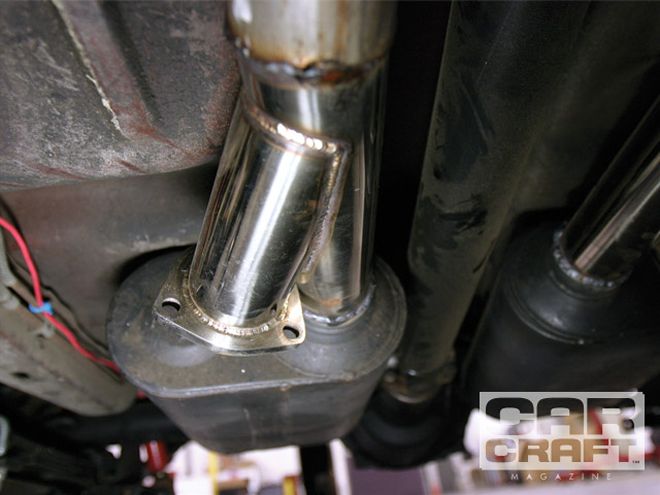
This is the mounting location that worked best for us. Notice how the floorpan kicks up just in front of the muffler. There is plenty of room here for the Y-pipe, cutout housing, and electric motor.
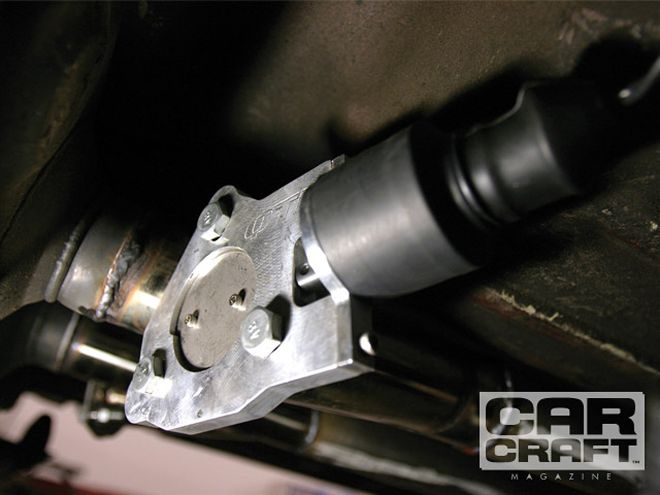
The standard Quick Time cutout housing mounts to the Y-pipe with a typical three-bolt flange. Bolt them in place and wire up the motors.
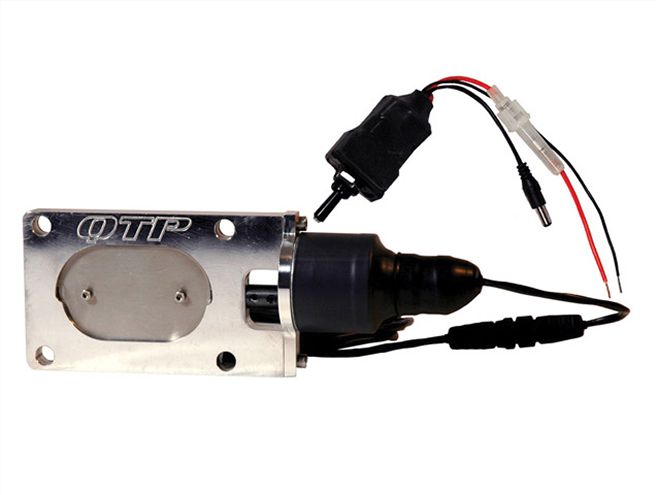
For cars with major clearance problems, Quick Time also sells these low-profile, oval-shaped cutouts.
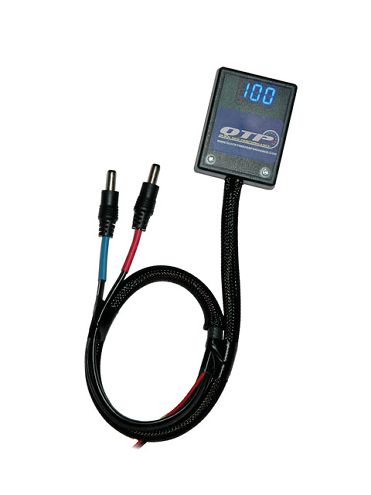
The kit is available with an optional remote control unit that can be mounted near the driver seat and allows complete control over the opening and closing of the cutouts. You can run them partially open during normal driving, fully open at the track or when you want to intimidate the guy next to you at the light, and fully closed when you're driving Grandma around.
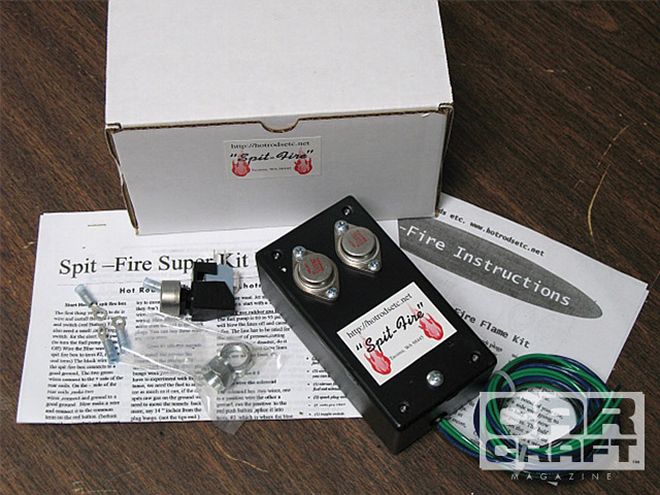 This is Hot Rods Etc's Spit Fire Show Flames kit that is designed to burn fuel injected into the exhaust system close to the spark plugs in the tailpipes.
This is Hot Rods Etc's Spit Fire Show Flames kit that is designed to burn fuel injected into the exhaust system close to the spark plugs in the tailpipes.
Flamethrower Kits
This is a more nebulous topic. Flamethrowers were popular in the cruising scene of the '50s and '60s but disappeared for a while until the dreaded scene in The Fast and the Furious in which cars drag racing down a street shot flames out of their single tailpipes. Since then, flamethrower kits have either been reviled or respected as the mode du jour of the properly riced-out ride. Whether you're on board with the notion of shooting flames out of your exhaust or not, you've got to admit there's been at least one time in your life when you've wished you could singe your bumper making a statement of some sort. Scorching tailgaters on the freeway comes immediately to mind.
While they'd look more at home shooting out of the tailpipes of a kustom lead sled or bomber, we can also think of a few over-the-top Pro Street cars or drag-pipe Harleys that could wield a flame-shooting exhaust as their coup de grce, solidifying an over-the-top, crowd-wowing persona.
Installing a flamethrower kit on your car requires a bit more ingenuity than cutouts do. Because they rely on un-burned fuel in the tailpipe to operate, pollution and emissions laws hamper companies from making an all-inclusive kit, so the buyer will have to shop around among several sources to come up with a system of his own.
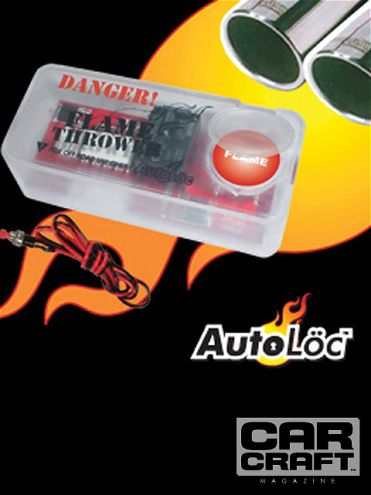 Auto Loc's flamethrower kit comes with its own ignition module-an electronic trigger that fires a pair of remote coils and operates independently from the car's ignition system. The advantage to this is you don't have to interrupt spark to the engine to light the fuel in the exhaust. This system is designed for noncatalyst cars as well, but industrious folks can probably figure out a way to richen up the exhaust stream.
Auto Loc's flamethrower kit comes with its own ignition module-an electronic trigger that fires a pair of remote coils and operates independently from the car's ignition system. The advantage to this is you don't have to interrupt spark to the engine to light the fuel in the exhaust. This system is designed for noncatalyst cars as well, but industrious folks can probably figure out a way to richen up the exhaust stream.
The principle is the same, no matter what. You need to have atomized fuel in your exhaust stream, either because of a rich-running engine or additional fuel added to the exhaust-and you need a way to ignite that fuel. This is usually done with spark plugs, though we've heard of some guys using glow plugs from a diesel engine. To spark the plugs, you need a coil and a triggering mechanism. The old-school guys would have a switch that teed off either the points or the ignition module that would trigger a pair of rear-mounted coils that fired spark plugs welded into the exhaust near the tailpipe tips. You'd rev the engine and flip the switch on overrun when the exhaust was full of unburned fuel. You could then keep the flames going by pulling the choke. Gasoline is a solvent, so be aware that setting up your engine to run this rich washes down the cylinder walls and eventually dilutes your engine oil. This shouldn't be a problem if you up your oil change intervals, though.
Spark plug placement is an important part of the equation. The plugs need to be near enough to the exhaust tips so that fuel in the pipes can mix with the outside air. There is not enough oxygen in the exhaust stream to react with the gasoline, allowing it to burn. Just like in an acetylene torch, the exhaust flames burn outside of the exhaust pipes, so the source of ignition needs to be right at the point where the exhaust is exiting the system. The typical distance is between 3 and 6 inches from the tips, but it can vary depending on the diameter of your exhaust tubing.
Fuel-injected engines pose an added set of problems because you need to reprogram the ECM to run a richer air/fuel ratio-you'd need access to tuning software or a tuner who is willing to write a program. However, catalytic converters pose a bigger problem than that. Modern catalysts do a great job of cleaning up unburned fuel in the exhaust, so you'd have to run a very rich A/F ratio that basically overwhelms the converters. However, this will cause the converters to overheat and will eventually destroy them. So you'd either need to remove the cats, which is illegal, or inject additional fuel after the converters.
Most flamethrower kits are designed for noncatalyst, carbureted cars, but Hot Rods Etc can sell you the components of a kit that will allow you to inject additional fuel after your catalytic converters for late-model cars. Though by law the company can't sell you all the parts in one box, DJ will provide you with a list of additional parts, like a fuel pump and injectors, needed to complete the kit. He stressed to us that although flamethrowers are fun, your first concern must be safety. Take care when installing the kit, aim the exhaust tips so that they don't burn or melt your car, and be aware of what or who is behind you when you flip the switch. Barbecues are great unless it's your car or your friends who have just become the main course.
Any of our readers have a set of flamethrowers on their cars? Outraged by a flamethrower article in Car Craft? Either way, let us know what you think at CarCraft.com. We've got our asbestos suits on.